إن نظام إدارة المعرفة الفعال هو قوة الحياة للمؤسسة - ولا عجب في ذلك. وسواء كانت الإرشادات المركزية الخاصة بالمشروع أو السياسات على مستوى الشركة، فأنت بحاجة إلى قاعدة منظمة لتخزين أصولك المعرفية ودعم فرق العمل عبر العمليات.
لكن سؤال المليون دولار هو كيف يمكنك بناء أفضل قاعدة معرفة داخلية لفريقك ؟
قد يكون إنشاء قاعدة معرفية جيدة التخطيط مهمة شاقة. على سبيل المثال، عليك التركيز على تقديم معلومات مفصلة وذات صلة في الويكي الداخلي الخاص بك مع ضمان إمكانية الوصول إلى كل شيء وتحديثه لأصحاب المصلحة المتعددين. إنها عملية مستهلكة للوقت وغير مستدامة، حتى مع وجود أفضل أدوات قاعدة المعرفة تحت تصرفك.
في هذه المقالة، سوف نستكشف مفهوم قواعد المعرفة الداخلية بالتفصيل ونناقش الخطوات المتبعة في إنشاء واحدة منها. سنقدم أيضًا:
- أفضل الممارسات والأساليب المتقدمة لتحسين أي مورد معلوماتي
- أكثر برامج قواعد المعرفة الداخلية ثراءً بالميزات وقابلية للتطوير للفرق 😍
ما هي قاعدة المعرفة الداخلية؟
تعمل قاعدة المعرفة الداخلية كمكتبة معلومات محدثة يمكن الوصول إليها حصريًا لموظفي المؤسسة. وهي عبارة عن قاعدة بيانات معرفية مركزية، ويفضل أن تكون مزودة بوظيفة البحث، مما يسمح للموظفين بالعثور على البيانات الداخلية حول جميع العمليات والخدمات القابلة للتسليم.
يخزن الحل النموذجي لقاعدة المعرفة الداخلية عناصر مثل:
- إجراءات التشغيل القياسية (SOPs)
- سياسات الشركة
- العقود والمستندات القانونية الأخرى
- الأصول الرقمية وموارد الشركة الفكرية
- معلومات وإرشادات المشروع
- دراسات الحالة وبيانات البحث
- أدلة فريق خدمة العملاء
لتسهيل الوصول إلى هذه المعلومات، يتم تنظيم قواعد المعرفة الداخلية باستخدام العلامات والفئات وأنواع أخرى من التسلسل الهرمي. 📚
قاعدة المعرفة الداخلية مقابل قاعدة المعرفة الخارجية
توفر قاعدة المعرفة الداخلية مصدرًا واحدًا للحقيقة لدعم موظفيك. تهدف قاعدة المعرفة الخارجية إلى القيام بنفس الشيء - ولكن لعملائك.
صُممت قواعد المعرفة الخارجية لتكون بمثابة وسيط خدمة ذاتية للعملاء، مع استكمالها بأدلة المنتج وحلول للمشاكل الشائعة. كما يمكن استخدامها من قبل الفرق التي تواجه العملاء لتقديم المزيد من الدعم العملي أثناء المكالمات.
الفوائد الرئيسية لقاعدة المعرفة الداخلية
إنشاء قاعدة معرفية داخلية يسهل تأهيل الموظفين بشكل أسرع وتحسين تعاون الفريق. نظرًا لأن جميع العمليات الداخلية موثقة في مكان واحد، فلن تحتاج إلى قضاء ساعات في اجتماعات الاتصال مع الموظفين الجدد أو فرق المشروع. ما عليك سوى تزويدهم بإمكانية الوصول إلى قاعدة المعرفة الداخلية الخاصة بك، وسيتم تمكينهم من أداء واجباتهم دون إضاعة الوقت في استشارة الآخرين.
تجلب هذه الأصول فوائد ملموسة أخرى، بما في ذلك:
- تقليل الأخطاء: عندما تكون المعلومات الدقيقة متاحة للموظفين بسهولة، فإن ذلك لا يترك مجالًا كبيرًا للأخطاء ويؤدي إلى زيادةرضا العملاء والاحتفاظ بهم
- وفورات أفضل في التكاليف بسبب إنتاجية الفريق: وفقًا لـتقرير ماكينزيفإن الموظف العادي يخسر حوالي 20% من ساعات عمله بحثًا عن المعلومات ذات الصلة. يمكن أن تؤدي سهولة توافر الأصول المعرفية المطلوبة إلى تحسين إنتاجية الموظف، مما يضمن الاستخدام الأمثل لمواردك المالية والبشرية
- احتفاظ أعلى بالموظفين: توضح قاعدة المعرفة الداخلية عمليات شركتك وسياساتها. وهذا يجعل تجربة العمل أكثر سلاسة ويؤدي إلى زيادة رضا الموظفين والاحتفاظ بهم
- عمليات قابلة للتطوير وخالية من الاحتكاك: تسمح قاعدة المعرفة الداخلية للشركات بأن تكون قابلة للتطوير بشكل كبير من خلالإجراءات التشغيل الموحدة المبسطةوكتيبات الموظفين ونقل المعرفة لتركيز جميع المعلومات التي يحتاجها فريقك.
استخدم هذا القالب لتبسيط مستندات الفريق الأساسية وتحسين إمكانية الوصول إليها داخل المشاريع
كيفية إعداد قاعدة معارف داخلية في 7 خطوات سهلة
إن إنشاء قاعدة معرفية وإدارتها ليس بالأمر السهل. فبادئ ذي بدء، تحتاج إلى تنظيم أنيق وتصميمات وصول أنيقة، بالإضافة إلى آلية سهلة لتحديث المستندات عند الضرورة.
الآن، إعداد قاعدة معرفية ليس عملية واحدة تناسب الجميع، لكننا قمنا بتبسيطها في سبع خطوات قياسية أدناه. من أجل التوضيح، قمنا بالاستفادة من بعض أدوات ووظائف قاعدة المعرفة لدعم كل خطوة. 🌸
الخطوة 1: إنشاء استراتيجية مصممة خصيصًا لإدارة المعرفة
قبل البدء في بناء قاعدة المعرفة الداخلية الخاصة بك، من الضروري أن يكون لديك استراتيجية واضحة لتوجيه العملية. حدد العناصر الأساسية لـ استراتيجية إدارة المعرفة مثل:
- حالات الاستخدام: هل تنشئ قاعدة معرفية للمعلومات الخاصة بالمشروع أو الشركة؟ ما هي الثغرات المعرفية التي تريد معالجتها ولمن؟
- الأدوار ومستويات الوصول: حدد الأدوار التي لها صلاحية تحرير قاعدة المعرفة وتحديثها. بالإضافة إلى ذلك، يمكنك أيضاً تحديد مجموعات لـ
- الوصول للعرض فقط
- الوصول على مستوى الشركة والوصول الخاص بالفريق
- المساهمون على مستوى الإدارة وضوابط الوصول الخاصة بهم
- التسلسل الهرمي للمحتوى: فكر في كيفية تنظيم المحتوى داخل القاعدة المعرفية - سواء كنت تريد تنظيمه حسب الأقسام,الأدوار والمسؤولياتأو المشاريع. خطط الفروق الدقيقة، بما في ذلك الفئات والعلامات وموقع التخزين، وفقًا لذلك
- إرشادات المحتوى: حدد عملية إنشاء المحتوى وإدارته. فكّر في مستوى التفاصيل المطلوبة، ونوع المحتوى (مقاطع الفيديو، والمقالات، والرسوم البيانية، وما إلى ذلك)، ونبرة الصوت المتناسقة، وقنوات الموافقة.
تخطيط هذه التفاصيل أولاً بأول سيمنحك الوضوح و توفير الوقت أثناء بناء قاعدة المعرفة . أسهل طريقة لتبادل الأفكار حول استراتيجيتك هي استخدام أدوات السبورة الرقمية مثل كليك أب السبورات البيضاء .
تقدم اللوحات البيضاء الرقمية عادةً لوحة لا نهائية لمساعدتك في رسم استراتيجية إدارة المعرفة الخاصة بك مع قادة فريقك. على سبيل المثال، باستخدام ألواح المعلومات الرقمية ClickUp Whiteboards، يمكنك استخدام الموصلات والملاحظات اللاصقة والكتل الملونة والعناصر المرئية الأخرى لتصميم تدفقات المعلومات ومستويات الوصول اللازمة عبر الأقسام.

قم بتخصيص اللوحات البيضاء بسهولة عن طريق إضافة المستندات والمهام والمزيد
الخطوة 2: اختر برنامج قاعدة المعرفة المناسب
بمجرد أن تكون لديك استراتيجية إدارة المعرفة الخاصة بك، اختر البرنامج المناسب برنامج إدارة المعرفة (KMS) لتنفيذ خططك
في حين أن اختيارك لأداة قاعدة المعرفة الداخلية يعتمد على احتياجاتك الخاصة، إليك ست ميزات يجب أن تبحث عنها:
- تسلسل هرمي متعدد المستويات: يجب أن تكون قادرًا على تنظيم نظام إدارة المعرفة الخاص بك وعناصره من خلال المجلدات والفئات العريضة والعلامات والصفحات الفرعية
- وظيفة بحث قوية: يجب أن تساعد وظيفة البحث في أداة قاعدة المعرفة الخاصة بك الموظفين في العثور على المعلومات التي يحتاجون إليها بسرعة باستخدام علامات المستندات وحتى المحتوى المكتوب
- ميزات التعاون: تعمل أفضل حلول إدارة المعرفة أيضًا كأدوات تعاون، مما يتيح لك العمل مع أعضاء فريقك لإنشاء مقالات بشكل أسرع. إعطاء الأولوية للبرامج التي تدعم العديد من المتعاونين لكتابة ومراجعة المستندات
- تنسيق النص الغني: يضيف تنسيق النص الغني ودعم محتوى الوسائط المتعددة إلى سهولة قراءة المحتوى وقيمته البصرية، مما يساعد القراء على فهم الموضوعات المعقدة بشكل أسرع
- دعم الذكاء الاصطناعي: أحدثتأتي حلول KMS مزودة بميزات الذكاء الاصطناعي التي تساعد على إنشاء المحتوى وتنسيقه من خلال المطالبات وحتى تحديد موقع المقالات ذات الصلة داخل قاعدة
- الوصول المستند إلى الويب: يجب أن يسمح حل قاعدة المعرفة الذي تختاره بالوصول السلس إلى المستخدمين عبر الويب من خلال بوابة آمنة
والخبر السار هو أن معظم أدوات قاعدة المعرفة عالية الجودة تحتوي بالفعل على هذه الميزات. ومع ذلك، إذا كنت تبحث عن شيء كامل الميزات وبأسعار معقولة، فاختر ClickUp * يأتي برنامج قاعدة المعرفة الداخلية هذا مزودًا أيضًا بوظائف التعاون في المشاريع وإدارة المهام، مما يجعله مثاليًا للفرق من أي حجم ومجال.
كحل لقاعدة المعرفة، تتضمن بعض ميزات ClickUp البارزة ما يلي:
- مستندات ClickUp مجموعة إدارة المستندات التعاونية
- تخزين غير محدود على جميع الباقات المدفوعة
- مساعد ذكاء اصطناعي أصلي لإنشاء المستندات والملخصات
- ضيوف للقراءة فقط مع أذونات مخصصة
الخطوة 3: تخطيط وإنشاء المحتوى الخاص بك
اختر برنامج قاعدة المعرفة ? لنبدأ في بناء قاعدة معرفية داخلية جيدة. أولاً، قم بإنشاء خطة حول ما يجب كتابته وأعضاء الفريق الذين سيقومون بذلك.
لا تشدد على كتابة جميع مستنداتك في وقت واحد - ابدأ بالأشياء الأساسية، مثل:
- معلومات الشركة الأساسية
- سياسات الإجازات والتعويضات
- جداول وإرشادات مراجعة الأداء
- الأسئلة المتداولة (FAQs)
- مكان العملمدونة قواعد السلوك
- المخططات التنظيمية
- مواد تدريبية للموظفين الجدد
- مواد التأهيل للعملاء
يمكنك الاستفادة من مستندات ClickUp لتخطيط وإنشاء المحتوى الخاص بك. ارفع مستنداتك الحالية إلى المنصة أو أنشئ مستندات جديدة من الصفر. من منظور العمليات، يمكنك
- إنشاءالمهام المعينة لكل مقالة قاعدة معرفية قيد الإنتاج
- تعيين عضو واحد أو أكثر من أعضاء الفريق لكل مهمة
- تتبع الوقت المستغرق في كتابة الوثائق ومراجعتها
تنسيق كل مستند باستخدام ميزات تنسيق النص المنسق - إضافة صور الغلاف والجداول والإشارات المرجعية والعناوين والعناوين الفرعية والمزيد لتحسين إمكانية قراءة المحتوى.

استخدم مستندات ClickUp Docs لإدارة المستندات المهمة وتعزيز تعاون الفريق
لتسريع عملية إنشاء المحتوى، استفد من قوة أداة الذكاء الاصطناعي المدمجة في ClickUp, ClickUp Brain . استخدم مطالباته القابلة للتخصيص الخاصة بالأدوار لإنشاء مستندات بسرعة مثل ملخصات المشاريع ودراسات الاختبار ومتطلبات البرامج.
يمكنك أيضًا استخدام ClickUp Brain لتحسين محتوى قاعدة المعرفة الحالية الخاصة بك من حيث القواعد النحوية والنغمة والوضوح. بالإضافة إلى ذلك، فإن ترجمة و تلخيص ميزات تضمن استيعاب موظفيك للمحتوى بسهولة.

استخدم ClickUp AI لتحرير أو تلخيص أو التدقيق الإملائي أو تعديل طول المحتوى داخل المستندات
الخطوة 4: تنظيم المحتوى الخاص بك للمساعدة في إمكانية البحث
بعد أن تنشئ المحتوى الخاص بك، حان الوقت لتنظيمه لسهولة اكتشافه. الفكرة هي مساعدة أي شخص في الوصول إلى مقالات محددة عن طريق تصفية قاعدة المعرفة. تتضمن بعض الطرق للقيام بذلك ما يلي:
- وضع علامات على كل مستند بعلامات ذات صلة (مثل "مواد تأهيلية" لجميع موارد تأهيل الموظفين)
- إنشاء جدول محتويات أو فهرس
- تنظيم المستندات حسب المشاريع أو العملاء أو معايير مماثلة
يتيح ClickUp إمكانية ضبط قاعدة المعرفة الخاصة بك من خلال التسلسلات الهرمية متعددة المستويات . يمكنك إنشاء مساحات عمل, مجلدات، ملفات والقوائم والفئات الفرعية الأخرى لتنظيم أصولك المعرفية وتخزينها.
على سبيل المثال، يمكنك إنشاء مجلد لـ المشروع أ أو قائمة مراجعة لإكمال المهمة XYZ - سيعرف موظفوك بشكل بديهي أين يبحثون.
تشمل الطرق الأخرى لتنظيم مستنداتك ما يلي: الترميز بالألوان العلامات و تسميات الأولوية . يمكن لفريقك الوصول إلى أي مستند في غضون ثوانٍ باستخدام البحث الشامل الميزة

تتيح ميزة ClickUp Universal Search للمستخدمين العثور بسرعة على المهام والمستندات والملفات والمستخدمين والمحادثات ولوحات المعلومات عبر مساحة العمل بأكملها وحتى تطبيقات العمل الأخرى المتصلة
تضمن ClickUp أيضًا تنظيمًا فائقًا من خلال الصفحات الفرعية المتداخلة، وهي مثالية لعرض المستندات ذات الموضوعات الفرعية المتعددة. ما عليك سوى سحب وإسقاط الموضوعات الفرعية تحت الصفحة الرئيسية، كما هو موضح في الصورة أدناه:

تتيح لك الصفحات الفرعية المتداخلة داخل مستندات ClickUp تنظيم مستنداتك أو مستندات الويكي بشكل أفضل
نصيحة سريعة: يمكنك أن تطلب من ClickUp Brain إنشاء جدول محتويات لمجلدات أو مجموعات مستندات معينة، أو إنشاء جداول لتنظيم أسرع، أو إنشاء نصوص تحويل الصوت إلى نص للكتابة أو الفهرسة.
الخطوة 5: ### الخطوة 5: تنفيذ ضوابط الوصول إلى قاعدة المعرفة
بمجرد تنظيم قاعدة المعرفة الداخلية الخاصة بك وتجهيزها، حوّل انتباهك نحو إمكانية الوصول. سيكون لكل برنامج إعداد مختلف لتحديد مشاركة المعرفة الأذونات. يمكنك عادةً اختيار عناصر تحكم دقيقة للعرض والتحرير بناءً على أدوار المستخدم أو موقع المستند.
على سبيل المثال، يتيح لك ClickUp تخصيص كل من عناصر التحكم المستندة إلى المستخدم ومساحة العمل. يمكنك ذلك:
- السماح بالوصول إلى المستخدمين داخل مساحة عمل أو مجلد معين
- مشاركة الوصول الفردي من خلال روابط خاصة
- استخدام رابط عام آمن لمشاركة المستندات مع العملاء والمتعاونين الخارجيين
يمكنك أيضًا الحصول على واجهة سهلة الاستخدام لدعوة المستخدمين الضيوف للوصول إلى قاعدة معارفك أو مستندات محددة من خلال البريد الإلكتروني. امنحهم تحرير و/أو مشاهدة فقط أذونات حسب ما تريد منهم القيام به.

التعاون هو المفتاح مع ClickUp 3.0 Docs حتى تتمكن من المشاركة أو تعيين الأذونات أو التصدير بسرعة إلى المستخدمين الداخليين أو الخارجيين
الخطوة 6: مراجعة قاعدة المعرفة الداخلية الخاصة بك
قم بتعيين مجموعة من المدققين (يمكن أن يكونوا أعضاء رئيسيين من أقسام مختلفة) لإضفاء لمسة نهائية على قاعدة المعرفة الداخلية الخاصة بك. يمكنهم التحقق من جوانب مثل:
- دقة وثائق معرفة الموظفين
- تكرار المعلومات نفسها عبر المقالات (بدلاً من الربط)
- مستويات الوصول غير الصحيحة
- أخطاء التنسيق والتدقيق اللغوي
- عدم تطابق المحتوى والعناوين
يمكن أن تكون عملية التدقيق سهلة مع ميزة ClickUp الغنية ميزات التعاون في المستندات . يمكن لفريقك استخدام التعليقات المعينة مباشر دردشة و تدقيق سير العمل أدوات داخل المنصة لتوصيل الأخطاء إلى المساهمين في المستندات وإصلاحها على الفور.

قم بالتحرير جنبًا إلى جنب مع الفريق، وإبداء التعليقات، وتفويض المهام للأعضاء الآخرين مباشرةً من مستند ClickUp الخاص بك
الخطوة 7: مراجعة وتحديث قاعدة المعرفة الداخلية بانتظام
لا تضع قاعدة معرفية داخلية وتنسى أمرها! يمكن لقاعدة معرفية قديمة أن تضلل زملائك في الفريق، لذا فإن إدارتها وتحديثها بشكل دوري أمر غير قابل للتفاوض.
من الحيل الأنيقة لترتيب قاعدتك المعرفية هي التخلص من المستندات التي لم تعد بحاجة إليها، مثل السياسات القديمة وأدلة فريق دعم العملاء القديمة. وبالمثل، قم بإضافة أحدث الأصول المعرفية إلى القاعدة وإخطار أصحاب المصلحة المعنيين.
4 أفضل الممارسات لإعداد قاعدة معرفية داخلية ## 4 أفضل الممارسات لإعداد قاعدة معرفية داخلية
الآن بعد أن تعرفت على عملية إعداد قاعدة معرفية داخلية، ألقِ نظرة على أفضل أربع ممارسات يمكن أن تساعدك على تحسين جودتها وموثوقيتها.
1. استخدم القوالب
يمكن أن يكون إنشاء قاعدة معرفية مملًا بشكل مؤلم ويستغرق وقتًا طويلاً، خاصة إذا بدأت بمستند فارغ. لهذا السبب تعتمد الفرق المنتجة على قوالب قاعدة المعرفة لإنشاء موارد قاعدة المعرفة اليومية.
يحتوي ClickUp على أكثر من 1,000 قالب لتسريع إنشاء المستندات عبر مختلف حالات الاستخدام، بما في ذلك سياسات الشركة وإجراءات التشغيل الموحدة وإرشادات المشروع. أفضل جزء هو أنك تحصل أيضًا على قوالب مخصصة لإعداد قواعد المعرفة الداخلية والخارجية - وتشمل القوالب المفضلة لدينا:
- قالب قاعدة المعرفة ClickUp: مثالي لإنشاء مكتبة معلومات رقمية متعددة الاستخدامات لأي شركة أو مشروع
- قالب قاعدة معارف ClickUp للموارد البشرية: مناسب لإدارة سياسات وإجراءات الموارد البشرية
- قالب عمليات وإجراءات ClickUp: يتيح لك إنشاء برامج تعليمية مفصلة خطوة بخطوة وتنظيم الإجراءات عبر لوحات كانبان

وفر الوقت لإنشاء قاعدتك المعرفية مع قوالب ClickUp المصممة مسبقًا
تأتي هذه القوالب بهياكل وأقسام قياسية جيدة التنسيق - كل ما عليك فعله هو إكمال المعلومات ذات الصلة بفريقك. 😎
2. اجمع ملاحظات الموظفين بشكل دوري
لا يستطيع معظم قادة الفرق تحديد جميع الثغرات المعرفية بأنفسهم. فهم بحاجة إلى النظر في ملاحظات الموظفين وتحديث القاعدة المعرفية لمعالجة المشكلات التي تم الكشف عنها، والتي يمكن أن تكون أي شيء بدءًا من المزيد من الاستفسارات إلى العمليات غير الواضحة.
إحدى الطرق لجمع الأسئلة الشائعة من كل قسم هي استخدام نماذج ClickUp . صمم نموذجًا داخليًا بأسئلة محددة لتحديد ما يصلح وما لا يصلح. قم بتحليل إجابات الموظفين بسهولة في عرض الجدول الخاص بالمنصة، وحدد الثغرات المعرفية وخطط لطرق إزالتها.

ابدأ استبيانًا لجمع التعليقات باستخدام نماذج قابلة للتخصيص بدرجة كبيرة على ClickUp
3. التركيز على سهولة القراءة
انتبه لجوانب العرض وسهولة القراءة عند تغطية موضوعات قاعدة المعرفة الداخلية الشاملة. أولاً، احرص على الكتابة بلغة خالية من المصطلحات ومفهومة للجميع أعضاء الفريق . على سبيل المثال، إذا كنت تشرح تكلفة اكتساب العميل (CAC) لفريق غير مسوّق، فقد ترغب في استخدام المصطلح بالكامل بدلاً من CAC.
تتضمن أفضل ممارسات الكتابة والتحرير الأخرى لحل قاعدة المعرفة ما يلي:
- استخدام الجداول والنقاط النقطية بدلاً من الفقرات الطويلة
- استخدام الرسومات أو الرسوم المتحركة
- وضع عناوين مباشرة وغنية بالمعلومات
- شرح الخطوات الإرشادية حيثما أمكن
4. استخدام التحليلات
للوهلة الأولى، قد يبدو للوهلة الأولى أن استخدام التحليلات لقاعدة معرفية أمر غير مناسب، ولكن البيانات ضرورية لتحسين أي شيء. يمكن أن تساعدك تحليلات استخدام قاعدة المعرفة الداخلية الخاصة بك على اكتشاف أنماط القراء وتوثيق الاتجاهات، مثل:
- المقالات الأكثر قراءة
- الكلمات المفتاحية الأكثر بحثاً
- المواضيع الأكثر تعليقًا (مما يشير إلى احتمال عدم الوضوح)
يمكن أن تساعدك هذه المعلومات في تحسين قاعدة معارفك للمستخدمين النهائيين وتعزيز الإنتاجية من حيث أوقات التصفح.
مقاربات متقدمة لقواعد المعرفة الداخلية الحديثة
كانت قواعد المعرفة في السابق عبارة عن خزائن من الملفات والوثائق المفهرسة. ومع ذلك، على مدى العقود القليلة الماضية، أثرت العديد من الأساليب المتقدمة على كيفية إنشاء البيانات وتصفحها بشكل جماعي.
البيئة التعاونية للويكي أو برامج قواعد المعرفة الداخلية
ظهور برنامج ويكي مع ميزات التعاون التي يمكن القول إن لها التأثير الأكبر على كيفية إدارة المعرفة وتوزيعها داخل المؤسسات.
فمن خلال السماح بتعدد المساهمين، فإنها تجعل من الممكن إنشاء صفحات معرفية مترابطة بشكل أسرع وبدقة أكبر. بالإضافة إلى ذلك، مع وجود أزرار مدمجة للتحقق من سجل التحرير وعكس التغييرات، هناك رؤية أفضل للمستندات سريعة التغير.
إلى جانب العمل كمستودع مركزي لبيانات الشركة، خلقت برامج الويكي الحديثة أيضًا فرصًا لزيادة قابلية توسيع نطاق المعرفة في المؤسسات. 🗄️
تأثير الذكاء الاصطناعي على إدارة المعرفة
أدى إدخال أدوات الذكاء الاصطناعي التوليدي غيرت بشكل كبير كيفية إنشاء المعرفة ومشاركتها من خلال قواعد المعرفة الداخلية. فأدوات الذكاء الاصطناعي مثل Scribe وClickUp Brain تختصر عملية كتابة وتنسيق ومراجعة الوثائق المعرفية.
بالإضافة إلى ذلك، بدلاً من تقديم قائمة بنتائج البحث، فإن العديد من برامج قواعد المعرفة المدعومة بالذكاء الاصطناعي تجيب الآن مباشرةً على أسئلة القراء بناءً على المحتوى المتاح في قاعدة المعرفة.
على سبيل المثال، يمكنك استخدام ClickUp Brain كمدير معارف مدعوم بالذكاء الاصطناعي. وهو عبارة عن شبكة عصبية تعمل كمستودع لمستنداتك ومهامك وفرقك في مساحة العمل الخاصة بك - يمكن لموظفيك طرح الأسئلة عليه مباشرةً لاستخراج الإجابات من قاعدة معارف الشركة. على سبيل المثال:
- _كيف تعمل عملية تتبع الأخطاء لدينا؟
- _ما هو الهدف من المهمة XYZ؟

قواعد المعرفة المستندة إلى منتدى الإنترنت
تتضمن المزيد والمزيد من قواعد المعرفة الداخلية منتدى للمناقشة حيث يمكن للموظفين تبادل الأفكار حول مستند ما. وهذا يسمح بـ تحديد أسرع للمشكلات وتوضيح مرتجل للشكوك المتعلقة بعناصر معرفية معينة. كما أنه يوفر قناة اتصال للموظفين لفهم الأساس المنطقي وراء إجراءات التشغيل الموحدة وأفضل الممارسات المبينة في قاعدة المعرفة بشكل أفضل.
دور المحررين في الوقت الحقيقي في قواعد المعرفة الحديثة
الوقت الحقيقي محررو النصوص التعاونية المضمنة في برامج قاعدة المعرفة الداخلية الحديثة أحدثت ثورة في كيفية إنشاء المحتوى وتحريره.
على سبيل المثال، يتيح ClickUp العديد من المتعاونين تحرير مستند في الوقت الحقيقي . هذه المحررات تساعدك على إنشاء قواعد معرفية في وقت قياسي بفضل الجهد الجماعي. لقد كان ذلك بمثابة تغيير قواعد اللعبة بالنسبة للمستندات التي تضم متعاونين من أقسام متعددة. فبدلاً من كتابة ومراجعة سير العمل متعدد الخطوات، يمكنك العمل مع جميع أصحاب المصلحة مباشرةً وتجنب الأخطاء أو العمل الزائد عن الحاجة.

التنسيق والتعاون بسهولة على المستندات جنبًا إلى جنب مع الفريق دون تداخل في ClickUp
تعظيم كفاءة الفريق مع ClickUp: أفضل برنامج لقاعدة المعرفة
من خلال إبقاء الجميع على نفس الصفحة، تُعد قاعدة المعرفة الداخلية مطلبًا بالغ الأهمية لضمان الكفاءة التنظيمية. وعلاوة على ذلك، ومع تزايد رقمنة الشركات، فإن جودة قاعدة المعرفة الخاصة بك تحدد مدى سرعة تدريب الموظفين وتقليل منحنى التعلم لديهم.
لحسن الحظ، لديك أدوات مثل ClickUp التي تبسّط عملية بناء قاعدة المعرفة وإدارتها بالكامل. قم بالتسجيل اليوم مجانًا وادفع بمؤسستك نحو الإنتاجية والكفاءة القائمة على المعرفة. 💃


